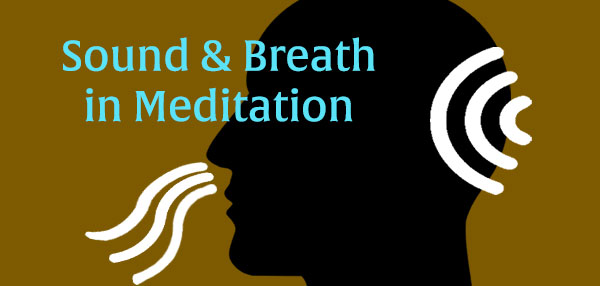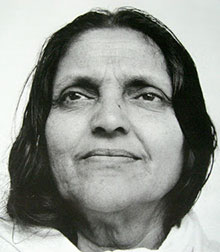
This article on Sound and Breath in Meditation is taken from “Perspectives on Yoga,” a book by Abbot George Burke to be published later this year.
Although there is a great deal of interest in gimmicks and tricks in yoga and endless expositions of “shakti” and suchlike, the yogi really has one all-absorbing interest: sound (shabda).
He begins with sound and ends with sound, and his involvement in sound is what carries him along the path and ensures his success and prevents his going astray. Those who do not follow this path will almost surely go astray and wander afar.
Every element (bhuta) has a sensory experience that is common or “native” to it.
- Earth (prithvi) has smell;
- water (apa) has taste;
- fire (agni) has sight;
- air (vayu) has touch;
- and ether (akasha) has sound (shabda).
The power of sound alone has both an active and passive aspect. Akasha possesses the power to both generate sound and to hear it. Furthermore, Akasha alone is pure; all the other elements have admixtures of one another, including akasha.
Even more, the elements predominate in each one of our five bodies.
- Earth predominates in the annamaya kosha, the physical body.
- Water predominates in the pranamaya kosha, the pranic body.
- Fire predominates in the manomaya kosha, the body that is the sensory mind.
- Air predominates in the jnanamaya kosha, the body of the intellect.
- Ether predominates in the anandamaya kosha, the body of the will.
The two powers of the Ether
Since Ether is the ruler of the elements, and it has two powers, will and sound, yoga is based on sound produced by the yogi’s will and in which he becomes absorbed in meditation.
This is an important principle to keep in mind because many aspirants throughout the ages have wasted their lives practicing methods not based on these two powers of ether, and therefore became wanderers, and often self-distracters and self-deluders.
The Word
“True, original Christianity is deeply rooted in the philosophy and yoga of India.”
We know the opening of Saint John’s Gospel: “In the beginning was the Word and the Word was with God and the Word was God.”
That, however is only a paraphrase of the Vedic verse: Prajapati vai idam agra asit. Tasya vak dvitiya asit. “In the beginning was Prajapati [God the Creator], and with him was the Word [Vak]” (Krishna Yajurveda, Kathaka Samhita, 12.5, 27.1; Krishna Yajurveda, Kathakapisthala Samhita, 42.1; Jaiminiya Brahmana II, Samaveda, 2244).
This shows that the true, original Christianity is deeply rooted in the philosophy and yoga of India, actually is the philosophy and yoga of India.
The world is generated (manifested) from/by sound: shabda or vak.
Sound is the foundation of all relative existence. Everything is Sound (Shabda). Sound is the foundation of all evolving life, and therefore the foundation of yoga itself.
The Atma and the Akasha
The atma and akasha are inseparable. From akasha arises shabda, divine sound which leads us to atma-bhava and then to atma-chaitanya: the Self. Then the jiva will be revealed as Shiva.
The chitta is the mind-intellect (manas-budhhi) complex. If the sensory, ego-oriented mind dominates the chitta, then it becomes soiled by the distraction, confusion and delusion that is inescapable in that condition. But if the buddhi dominates the chitta and maintains its ascendency, then it becomes purified and becomes chidakasha, the ether of space. In that akasha atmic consciousness arises automatically and reigns. That is why the last sutra of the Brahma Sutras says that enlightenment is attained through sound. Sound arises in akasha, and sound and consciousness are inseparable.
Sound and Breath: Mantra Joined to the Breath
The Upanishads say right from the beginning that sound and breath are the two fundamental spiritual powers of the human being, and are to be united to accomplish the destiny of the human being: liberation.
“The more inward (internal) our awareness, the more one-pointed it will be.”Many aspiring yogis struggle to make the mind one-pointed and mostly tire and frustrate themselves in the trying. This is because they think of one-pointedness as a condition of the mind, something it can be forced or moulded into. But one-pointedness is a matter of mental orientation.
The more inward (internal) our awareness, the more one-pointed it will be. So it is a matter of directing our mind, which is a major reason for linking japa with the breath.
Since the breath originates at the core of our being it is the most accessible means to lead the mind inward in meditation. And breath awareness along with japa outside meditation keeps the mind tending inward. After all, the word Atman comes from the root word at which means “to breathe.” So the Self is the original Breather.
Whenever our attention is not as one-pointed as we wish, it is because the mind is not fully turned inward. That is why breath awareness and absorption of the mind in listening to the mental intonations of a mantra are so necessary. Those two factors will take care of everything in time.
Sound and Breath together: the highest form of Japa

I well remember an evening in the 1968 Samyam Sapta in Dehra Dun when Ma Anandamayi spoke at length on the need to join mantra japa with the breath at all times. Some years later, also in Dehra Dun, I described the way I joined mantra japa to my breath, focusing my attention on the sound of the mantra alone without any kind of visualization, just becoming absorbed in the sound.
Mataji clapped her hands together and exclaimed (in Bengali): “Very good! This is the highest form of japa! Do that always.” Breath and sound are the oil and flame in the lamp of meditation. Not only is the body unable to move without breath, there is no movement upward of consciousness in meditation without the union of breath and mantra. That is why Anandamayi Ma said: “Nothing can be achieved without cultivation of the breath.”
The breath is the helm of meditation, and it moves us onward to the goal when mantra is joined to it.
Power and Will: two essential ingredients in meditation
Meditation requires two things: power and intelligent direction. Breath is the power and mantra directs that power upward into the Sahasrara where illumination begins to dawn. The yogi is at all times aware of what is going on and directs everything according to his intelligent will. Even if he simply watches and observes the yogic process, still he is willing (directing) that to be so. He is in charge at all times.
Those who are not in charge but believe they are being uncontrollably swept along “by the shakti” are deluded and in grave danger.
Breath is the rope which either elevates or lowers our level of awareness. Breath is a manifestation of consciousness, and therefore the means to mastery of consciousness. Sound and breath conjoined is the path to Self-realization.
The true breath is inside the outer, physical breath. It is already eternal. But when tied to the body it is agitated and struggles against its feeling of bondage and alienation. Many think that breath itself is the problem, but it is the state of being tied to the body that is the problem. When the inner breath is contacted and made to pervade our experience, then we move onward to freedom and our natural state.
Japa and meditation consisting of joining mantra to the breath joins the buddhi and manas, and then unites them with the Paramatman.
Mahaprana, the undifferentiated, intelligent cosmic life-force
The shabda (sound) which arises in the akasha during yoga sadhana is also the Mahaprana, the undifferentiated, intelligent cosmic life-force that becomes the five pranas. All things contain the Mahaprana and are manifestations of the Mahaprana. Mahaprana is the dynamic aspect of universal Consciousness; the superconscious Divine Life in all things.
In the lesser levels of the individual and the cosmos, prana moves as the force of life, but in the higher levels Mahaprana moves as the unalloyed Divine Life, which includes Divine Sound that is embodied in mantra. Because of this, repetition of a mantra both lifts the yogi up to and invokes the Mahaprana, enabling the yogi to truly live the Divine Life.
There are two kinds of sound: ahata (shabda) and anahata (nada). Ahata occurs in nature, is material sound even when subtle, but anahata is Divine Sound (Divya Shabda) and is spiritual, conveying spiritual opening and insight. Only the proficient yogi whose perceptions have been refined can hear these true sounds (Sat Nada) during his practice, for mantra sadhana opens the yogi to the inflow of Mahaprana and increases the inflow the longer it is practiced.
For this reason mantra japa is itself pranayama, especially when the mantra is joined to the breath.
Sound and Breath and the Kundalini
“Japa and the breath must never become separated.”Shabda and kundalini are essentially the same in the yogi. Through joining mantra to the breath (which is the true and highest pranayama) the kundalini is activated and through that activation the mantra comes to its fruition in moksha.
Japa and the breath must never become separated. This creates the resolve and aspiration that is the highest bhakti and leads to mukti itself.
The only way to fix our attention on the buddhi, to center our consciousness in the buddhi, is through sound and breath centered in the sahasrara. Then our consciousness can merge into the heart-space, the chidakasha, in which pure consciousness alone exists, the consciousness which is our true Self as well as the Supreme Self.
Mantra, Breath, and mind power
The first step for a yogi is to become aware of the subtle forces moving in the body. This is accomplished by meditation in which mantra and breath are joined.
Then the yogi begins to realize what the mind really is and becomes able to “do” things by mind power alone. When he is further adept, he accomplishes things by the silent willing. Yogananda said that Jesus healed in this way by his divine, unlimited will.
Experience of our immaterial nature alone will lead to the realization that we are not the body. First, as said above, we start out in the realm of the mind (manas), then the intellect (buddhi) and finally the consciousness, the spirit itself. Then we truly know ourself.
Double mastery
“Internally we must always be immersed in the Divine through japa and meditation.”We must master both the energy (shakti) and the sound (shabda) aspects of a mantra. The energy aspect brings about certain experiences, from simple feelings to visual and auditory impressions. The sound aspect is mastered by making sure we pronounce the mantra exactly correctly, never “losing” it in an abstract state, and following it through all its subtle permutations to its silent form and entering into the consciousness it embodies.
Internally we must always be immersed in the Divine through japa and meditation, which become the two illumined eyes through we shall see ourselves, others and the world. That is jnana. When the mind is immersed in the Self, desires are gone like the illusions they were. Then bliss and liberation are ours.
All living things produce sound, and the Sanskrit language is a verbal reproduction of the sound patterns that are the sonic blueprint of all objects, conditions, and bhavas (mental states). Shabda is life, the primal sound-impulse at the heart of all manifesting things, physical, mental, and spiritual.
Further Reading:
Read Soham Yoga: The Yoga of the Self: An In-Depth Guide to Effective Meditation on our website or in the paperback or ebook.







